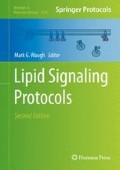Abstract
Liposome flotation assays are a convenient tool to study protein–phosphoinositide interactions. Working with liposomes resembles physiological conditions more than protein–lipid overlay assays, which makes this method less prone to detect false positive interactions. However, liposome lipid composition must be well-considered in order to prevent nonspecific binding of the protein through electrostatic interactions with negatively charged lipids like phosphatidylserine. In this protocol we use the PROPPIN Hsv2 (homologous with swollen vacuole phenotype 2) as an example to demonstrate the influence of liposome lipid composition on binding and show how phosphoinositide binding specificities of a protein can be characterized with this method.
Access this chapter
Tax calculation will be finalised at checkout
Purchases are for personal use only
References
Kelly BT, McCoy AJ, Spate K, Miller SE, Evans PR, Honing S, Owen DJ (2008) A structural explanation for the binding of endocytic dileucine motifs by the AP2 complex. Nature 456(7224):976–979. doi:10.1038/nature07422
Dove SK, Piper RC, McEwen RK, Yu JW, King MC, Hughes DC, Thuring J, Holmes AB, Cooke FT, Michell RH, Parker PJ, Lemmon MA (2004) Svp1p defines a family of phosphatidylinositol 3,5-bisphosphate effectors. EMBO J 23(9):1922–1933. doi:10.1038/sj.emboj.7600203
Yu JW, Lemmon MA (2001) All phox homology (PX) domains from Saccharomyces cerevisiae specifically recognize phosphatidylinositol 3-phosphate. J Biol Chem 276(47):44179–44184. doi:10.1074/jbc.M108811200
Krick R, Busse RA, Scacioc A, Stephan M, Janshoff A, Thumm M, Kühnel K (2012) Structural and functional characterization of the two phosphoinositide binding sites of PROPPINs, a beta-propeller protein family. Proc Natl Acad Sci U S A 109(30):E2042–E2049. doi:10.1073/pnas.1205128109
Baskaran S, Ragusa MJ, Boura E, Hurley JH (2012) Two-site recognition of phosphatidylinositol 3-phosphate by PROPPINs in autophagy. Mol Cell 47(3):339–348. doi:10.1016/j.molcel.2012.05.027
Corbin JA, Evans JH, Landgraf KE, Falke JJ (2007) Mechanism of specific membrane targeting by C2 domains: localized pools of target lipids enhance Ca2+ affinity. Biochemistry 46(14):4322–4336. doi:10.1021/bi062140c
Perez-Lara A, Egea-Jimenez AL, Ausili A, Corbalan-Garcia S, Gomez-Fernandez JC (2012) The membrane binding kinetics of full-length PKCalpha is determined by membrane lipid composition. Biochim Biophys Acta 1821(11):1434–1442. doi:10.1016/j.bbalip.2012.06.012
Busse RA, Scacioc A, Hernandez JM, Krick R, Stephan M, Janshoff A, Thumm M, Kühnel K (2013) Qualitative and quantitative characterization of protein-phosphoinositide interactions with liposome-based methods. Autophagy 9(5):770–777. doi:10.4161/auto.23978
Lemmon MA (2008) Membrane recognition by phospholipid-binding domains. Nat Rev Mol Cell Biol 9(2):99–111. doi:10.1038/nrm2328
Narayan K, Lemmon MA (2006) Determining selectivity of phosphoinositide-binding domains. Methods 39(2):122–133. doi:10.1016/j.ymeth.2006.05.006
Yu JW, Mendrola JM, Audhya A, Singh S, Keleti D, DeWald DB, Murray D, Emr SD, Lemmon MA (2004) Genome-wide analysis of membrane targeting by S. cerevisiae pleckstrin homology domains. Mol Cell 13(5):677–688
Gallego O, Betts MJ, Gvozdenovic-Jeremic J, Maeda K, Matetzki C, Aguilar-Gurrieri C, Beltran-Alvarez P, Bonn S, Fernandez-Tornero C, Jensen LJ, Kuhn M, Trott J, Rybin V, Muller CW, Bork P, Kaksonen M, Russell RB, Gavin AC (2010) A systematic screen for protein-lipid interactions in Saccharomyces cerevisiae. Mol Syst Biol 6:430. doi:10.1038/msb.2010.87
van den Bogaart G, Holt MG, Bunt G, Riedel D, Wouters FS, Jahn R (2010) One SNARE complex is sufficient for membrane fusion. Nat Struct Mol Biol 17(3):358–364. doi:10.1038/nsmb.1748
Schuette CG, Hatsuzawa K, Margittai M, Stein A, Riedel D, Kuster P, Konig M, Seidel C, Jahn R (2004) Determinants of liposome fusion mediated by synaptic SNARE proteins. Proc Natl Acad Sci U S A 101(9):2858–2863. doi:10.1073/pnas.0400044101
Dove SK, Dong K, Kobayashi T, Williams FK, Michell RH (2009) Phosphatidylinositol 3,5-bisphosphate and Fab1p/PIKfyve underPPIn endo-lysosome function. Biochem J 419(1):1–13. doi:10.1042/BJ20081950
Watanabe Y, Kobayashi T, Yamamoto H, Hoshida H, Akada R, Inagaki F, Ohsumi Y, Noda NN (2012) Structure-based analyses reveal distinct binding sites for Atg2 and phosphoinositides in Atg18. J Biol Chem 287(38):31681–31690. doi:10.1074/jbc.M112.397570
Krick R, Tolstrup J, Appelles A, Henke S, Thumm M (2006) The relevance of the phosphatidylinositolphosphat-binding motif FRRGT of Atg18 and Atg21 for the Cvt pathway and autophagy. FEBS Lett 580(19):4632–4638. doi:10.1016/j.febslet.2006.07.041
Stromhaug PE, Reggiori F, Guan J, Wang CW, Klionsky DJ (2004) Atg21 is a phosphoinositide binding protein required for efficient lipidation and localization of Atg8 during uptake of aminopeptidase I by selective autophagy. Mol Biol Cell 15(8):3553–3566. doi:10.1091/mbc.E04-02-0147
Bieniossek C, Nie Y, Frey D, Olieric N, Schaffitzel C, Collinson I, Romier C, Berger P, Richmond TJ, Steinmetz MO, Berger I (2009) Automated unrestricted multigene recombineering for multiprotein complex production. Nat Methods 6(6):447–450. doi:10.1038/nmeth.1326
Acknowledgements
We thank Geert van den Bogaart for advice and discussions. This work was supported by a SFB860 grant to M.T. and K.K.
Author information
Authors and Affiliations
Corresponding author
Editor information
Editors and Affiliations
Rights and permissions
Copyright information
© 2016 Springer Science+Business Media New York
About this protocol
Cite this protocol
Busse, R.A., Scacioc, A., Schalk, A.M., Krick, R., Thumm, M., Kühnel, K. (2016). Analyzing Protein–Phosphoinositide Interactions with Liposome Flotation Assays. In: Waugh, M. (eds) Lipid Signaling Protocols. Methods in Molecular Biology, vol 1376. Humana Press, New York, NY. https://doi.org/10.1007/978-1-4939-3170-5_13
Download citation
DOI: https://doi.org/10.1007/978-1-4939-3170-5_13
Publisher Name: Humana Press, New York, NY
Print ISBN: 978-1-4939-3169-9
Online ISBN: 978-1-4939-3170-5
eBook Packages: Springer Protocols

